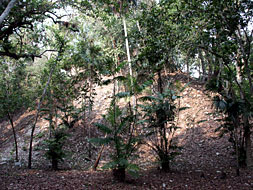World Monuments Fund has added the sites of Naranjo in Guatemala and Chalcatzingo in Mexico to its World Monuments Watch list of "100 Most Endangered Sites 2006." According to the September 2005 issue of the Fund's quarterly publication World Monuments Icon:
The Maya city of Naranjo was settled in the mid-first millenium B.C., reaching its apogee in the Late Classic Period (ca. A.D. 600-900) when most of its monuments were built. Inscriptions on stelae and altars at the stie chronicle some 345 years of history, from which it is clear that the city's fortunes were tied to its success in war against its rivals Tikal, Caracol, and Calakmul. The site, which has not been fully mapped, is threatened by forest fires, erosion, population encroachment, and looting, which has stripped it of archaeological material and destabilized surviving remains.
On a visit to Naranjo in June of this year, epigrapher Simon Martin could not help but be impressed anew by the site. He related his observations in a message to Mesoweb:
The clearing of undergrowth at Naranjo gives the visitor a clear impression of the sheer scale of Naranjo's architectural core. While mapping attests to its modest extent, its pyramids and palaces are steep and densely packed—more like an ancient Manhattan than the LA-style of widely distributed centers so typical of its peers. We do not know how early these remains might be, but such huge construction elsewhere usually signals a lengthy history and early phases buried deep within later ones. Naranjo's monuments—long since looted or removed for safety—tell of military successes and a fair measure of regional dominance. Yet a fuller picture gained from inscriptions elsewhere shows that it also saw conquest by rivals Calakmul in AD 631 and Tikal in 744, and suffered periods of subordination to these superpowers. An important episode in 693 saw the accession of a five-year-old boy as king under the regency of his mother and the protection of an overlord, the ruler of Calakmul. The young man grew into a successful warrior and commissioned many of the finest monuments erected at the site [see Mesoweb Encyclopedia sub K'ak' Tiliw Chan Chaak].
World Monuments Icon has this to say about Chalcatzingo:
Founded in the mid-second milennium B.C., the ancient Olmec ceremonial center of Chalcatzingo has yielded abundant sculptures that have provided a wealth of information about this early Prehispanic culture, which flourished in central Mexico and along the Gulf Coast in what are now the states of Tabasco and Veracruz between 1500 and 100 B.C. A series of temples, plazas, and a ballcourt have survived at the site, although they are not well preserved.
Despite its importance, Chalcatzingo, which has been poorly investigated, faces an uncertain future as its architectural remains continue to be harvested for modern building projects. Much of the archaeological zone is regularly overrun by cattle from an adjacent ranch. The Morelos state office of Mexico's Insituto Nacional de Antropología e Historia hopes to build shelters over vulnerable remains and control access to the site. Chalcatzingo will remain at risk until plans are drafted for its long-term management and conservation.
|


